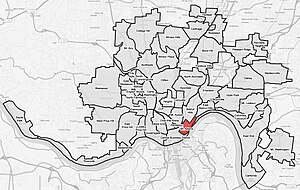Mount Adams, Cincinnati
| Mount Adams | |
|---|---|
 Mt. Adams (red) within Cincinnati |
Mt. Adams is a geographic landmark and residential neighborhood of Cincinnati, Ohio, located directly east of downtown Cincinnati, south of Walnut Hills, south-west of East Walnut Hills, and west of the East End.
Mt. Adams is surrounded by one of Cincinnati's finest parks—Eden Park. The park borders the hill on three sides and gives residents a sense of removal from the hustle and bustle of the city. Located within the park is the Krohn Conservatory and one of Cincinnati's oldest water works projects, now part of the park. Mt. Adams landmarks include the Cincinnati Art Museum, Playhouse in the Park, Rookwood Pottery (now converted to a restaurant), Pilgrim Presbyterian Church, Holy Cross Monastery and the Immaculata Church.
The 1,491 residents of Mt. Adams have a per capita income of $79,981.
Mount Adams was originally known as Mount Ida. The namesake was from Ida Martin, a washerwoman who lived in the hollow of an old sycamore tree located on a steep hill.
In the early 1800s the steep Mount Adams hillside was largely barren as early settlers had cut down all the trees for timber to construct their homes.
In 1831, Nicholas Longworth, a wealthy attorney, purchased the mansion that is now the Taft Museum of Art and the large lot of land behind including barren Mount Adams. He transformed the hill into a vineyard. Longworth would become the first commercially successful winemaker in the United States, and has been called the "Father of the American Wine Industry." During the 1830s and 1840s Longworth cultivated Catawba grapes, which were used in making his champagne known as Golden Wedding. The wine inspired Henry Wadsworth Longfellow to write the poem "Ode to the Catawba Wine." Contemporaries reported that Longworth's wine "transcends the Champagne of France." The winemaking industry around Cincinnati grew rapidly for several decades until it was virtually destroyed by downy mildew, powdery mildew, and black rot around 1860. The American Civil War created a shortage of manpower needed for vineyard labor, and the death of Longworth in 1863 furthered the end of Cincinnati's wine industry.
...
Wikipedia
